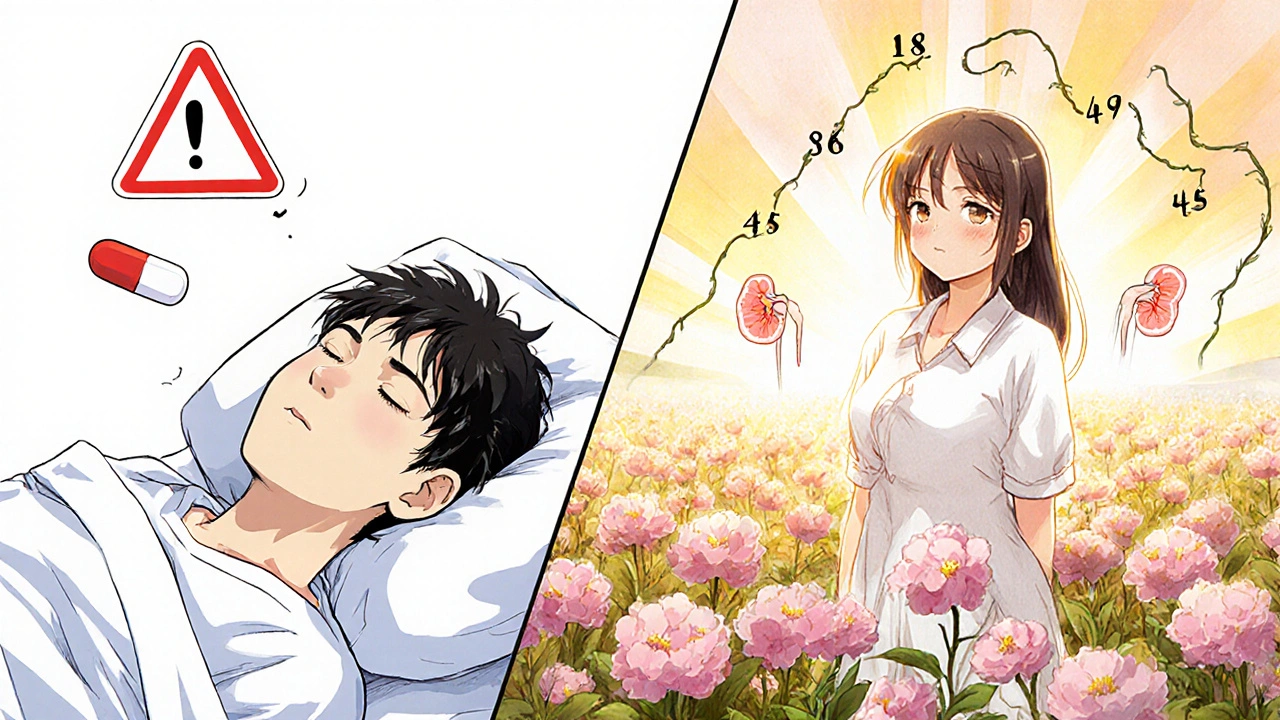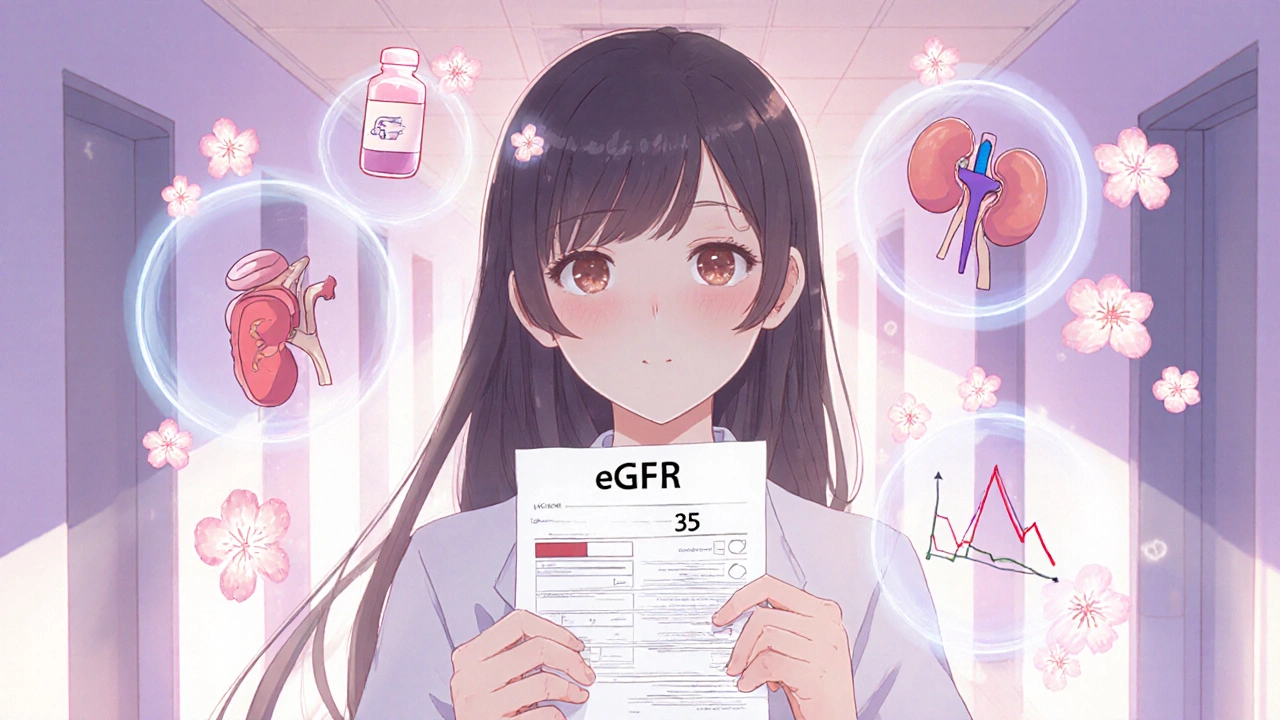CKD Diabetes Medication Dosing Calculator
Check Your Medication Safety
Enter your eGFR (estimated glomerular filtration rate) to see if your current diabetes medications are safe to continue.
Your Results
Metformin
Dosing recommendations based on your eGFR
SGLT2 Inhibitors
Dosing recommendations based on your eGFR
Important Considerations
When Your Kidneys Slow Down, Your Diabetes Meds Must Change
If you have Type 2 Diabetes and Chronic Kidney Disease (CKD), you’re not alone. About 1 in 3 adults with diabetes also have some level of kidney damage. What many don’t realize is that the same medications that help control blood sugar can become risky-or even dangerous-if your kidney function drops. Two of the most common diabetes drugs, metformin and SGLT2 inhibitors, need careful handling when your kidneys aren’t working at full speed. The old rules are outdated. New guidelines from 2022 changed everything-and many doctors are still catching up.
Here’s the reality: You don’t need to stop these drugs just because your kidneys are weaker. In fact, stopping them too early might be more harmful than keeping them on. The key is knowing exactly when to reduce the dose, when to pause, and when to keep going-even if your kidney numbers look bad.
Metformin: Safer Than You Think, But Still Tricky
Metformin has been the go-to first-line drug for Type 2 Diabetes since the 1990s. For years, doctors avoided it in CKD patients because of fears about lactic acidosis-a rare but serious condition where lactic acid builds up in the blood. But that fear was based on old data from the 1970s, when a different drug (phenformin) caused the problem. Metformin is much safer.
The 2022 KDIGO guidelines updated the rules completely. Now, metformin is considered safe even when your eGFR (a measure of kidney function) drops to 30 mL/min/1.73 m². That’s a big shift from the old cutoff of 60. Here’s how dosing works now:
- eGFR ≥60: Standard dose-up to 2,000 mg daily, split into two doses.
- eGFR 45-59: Max dose is 1,000 mg per day. If you’re older, dehydrated, or have heart failure, start low.
- eGFR 30-44: Max 1,000 mg daily. Don’t increase beyond this, even if your blood sugar is high.
- eGFR below 30: Stop metformin. Do not restart unless your kidneys recover and stay stable for weeks.
Many doctors still stop metformin too soon. A 2021 survey found that 45% of primary care providers discontinued metformin even when eGFR was above 30. That’s unnecessary. Metformin doesn’t cause lactic acidosis in CKD patients unless they’re acutely ill-like during a heart attack, severe infection, or dehydration. If you’re stable, keep taking it.
One mistake that causes real harm: stopping metformin during a temporary drop in eGFR. If you get sick, your kidneys might dip below 30 for a few days. Don’t panic. Hold metformin only during the acute illness. Restart it once you’re back to normal and your eGFR has been stable for at least a week.
SGLT2 Inhibitors: The Game-Changer for Kidneys
If you have diabetes and CKD, one of the most important decisions you can make is starting an SGLT2 inhibitor. These drugs-like dapagliflozin, empagliflozin, canagliflozin, and ertugliflozin-don’t just lower blood sugar. They protect your kidneys and heart. The evidence is so strong, experts now call them foundational therapy.
The big change in 2022? You can start them even if your eGFR is as low as 20 mL/min/1.73 m². Before that, the cutoff was 30. Now, if you’re at eGFR 22, you’re still a candidate. And here’s the surprise: you can keep taking them even if your eGFR drops below 20. In the DAPA-CKD trial, 11% of patients had baseline eGFR between 25 and 30. Many ended up below 20 over time-and still benefited.
These drugs work by making your kidneys flush out extra sugar and salt. That lowers blood pressure, reduces kidney stress, and slows damage. The EMPA-KIDNEY trial (2023) showed empagliflozin reduced the risk of kidney failure or heart-related death by 28% in people with eGFR as low as 20. That’s not a small benefit. That’s life-changing.
The doses you need are the lowest ones:
- Dapagliflozin: 10 mg daily
- Empagliflozin: 10 mg daily
- Canagliflozin: 100 mg daily
- Ertugliflozin: 5 mg daily
Higher doses don’t give you more kidney protection. They just raise your risk of side effects. Stick to these low doses. They’re all you need.
What Can Go Wrong? Side Effects You Should Know
No drug is perfect. Both metformin and SGLT2 inhibitors have risks-but they’re manageable if you know what to watch for.
With metformin, the biggest danger is lactic acidosis. But it’s rare-only 3 to 10 cases per 100,000 people per year in the general population. In CKD, that number rises slightly, but still stays low if you follow dosing rules. Symptoms? Unusual tiredness, muscle pain, trouble breathing, stomach pain, dizziness. If you feel this way, stop metformin and get help.
SGLT2 inhibitors come with their own set of issues:
- Genital yeast infections: More common in women (4-5%) than men (1-2%). Keep the area clean and dry. If you get recurrent infections, talk to your doctor about antifungal treatments.
- Dehydration and low blood pressure: These drugs make you pee more. If you’re on diuretics, elderly, or have low blood pressure, you might feel lightheaded. Drink water. Avoid skipping meals or getting overheated.
- Euglycemic diabetic ketoacidosis (DKA): This is rare-about 0.1-0.2% of users. But it’s dangerous because your blood sugar might not be high. You might feel nauseous, have abdominal pain, or breathe deeply and fast. If you’re sick, stop SGLT2 inhibitors and check ketones with a urine strip or blood meter.
Don’t panic about DKA. It’s not common. But if you’re sick with vomiting, fever, or infection, hold your SGLT2 inhibitor until you’re better. Don’t wait for your blood sugar to spike.
Combining Both: The Best Strategy for CKD
For most people with Type 2 Diabetes and CKD, the best approach isn’t metformin or an SGLT2 inhibitor. It’s both.
The KDIGO 2022 guidelines say clearly: if your eGFR is 30 or above, start both drugs together. Metformin handles blood sugar. SGLT2 inhibitors protect your kidneys and heart. Together, they’re stronger than either alone.
One study from Baylor College of Medicine found that only 37% of eligible patients with eGFR 20-29 were on an SGLT2 inhibitor. Why? Doctors were afraid. But the data says: if you’re stable, start it. If you’re already on metformin, add the SGLT2 inhibitor. Don’t wait for your kidney function to get worse.
When combining these with other diabetes drugs, watch for low blood sugar. If you’re also on a sulfonylurea (like glimepiride) or insulin, reduce those doses by 20-50%. SGLT2 inhibitors lower blood sugar on their own. You don’t need extra insulin or pills that push it lower.

Monitoring: What You Need to Check and When
These drugs aren’t set-and-forget. You need to track your kidney function and watch for warning signs.
For metformin:
- Check eGFR every 3-6 months if your kidney function is stable.
- Check every 1-3 months if your eGFR is below 45.
- Stop immediately if eGFR falls below 30.
For SGLT2 inhibitors:
- Check eGFR every 3 months, especially in the first year.
- Watch for signs of infection-itching, redness, discharge in the genital area.
- Check blood pressure and hydration, especially if you’re older or on diuretics.
- Test for ketones if you feel unwell, even if your blood sugar is normal.
Also, if you’re taking a mineralocorticoid receptor antagonist like finerenone (often used with SGLT2 inhibitors), check potassium levels. If it goes above 5.5 mmol/L, stop finerenone until it drops below 5.0.
Why So Many People Are Still Getting It Wrong
Despite the clear guidelines, real-world practice is lagging. A 2022 survey of 1,200 primary care doctors found that only 34% knew the correct eGFR thresholds for both metformin and SGLT2 inhibitors. After a 60-minute training session, that jumped to 78%. That tells you something: the problem isn’t lack of evidence. It’s lack of education.
Many doctors still think: “eGFR below 30? Don’t give metformin.” But the guidelines say: “eGFR below 30? Stop it.” There’s a difference. You can still use it at 31, 35, even 40. You just can’t use the full dose.
Another issue: cost and access. A 2023 study found SGLT2 inhibitors were used 3.2 times more often in high-income patients than low-income ones. These drugs can be expensive, and not all insurance covers them for CKD. If you’re struggling to afford them, ask about generics, patient assistance programs, or alternative brands.
What’s Coming Next?
The science is still moving. The ZEUS trial is testing dapagliflozin in people with eGFR as low as 15. Results are expected in late 2025. Early data from the DAPA-CKD-Extension study suggests SGLT2 inhibitors may even be safe for people on dialysis.
What’s clear now: if you have diabetes and CKD, you need to be on an SGLT2 inhibitor if your eGFR is 20 or above. You should be on metformin too-if your kidneys can handle it. The goal isn’t just to control blood sugar. It’s to keep your kidneys working longer, your heart stronger, and your life better.
Can I take metformin if my eGFR is 35?
Yes, you can. At an eGFR of 35 mL/min/1.73 m², the maximum daily dose of metformin is 1,000 mg. Do not exceed this amount. Your doctor should monitor your kidney function every 3-6 months. If your eGFR stays stable, you can continue safely.
Is it safe to start an SGLT2 inhibitor if my eGFR is 22?
Yes. According to the 2022 KDIGO guidelines, SGLT2 inhibitors can be started at eGFR ≥20 mL/min/1.73 m². The lowest effective doses-like dapagliflozin 10 mg or empagliflozin 10 mg-are safe and proven to slow kidney decline. You can continue them even if your eGFR drops further.
Should I stop my SGLT2 inhibitor if I get sick?
Yes, temporarily. If you have a serious illness-like infection, vomiting, dehydration, or surgery-stop your SGLT2 inhibitor until you recover. These drugs increase the risk of euglycemic diabetic ketoacidosis when you’re unwell. Restart once you’re eating normally and your kidney function is stable.
Can I take metformin and an SGLT2 inhibitor together?
Yes, and it’s recommended. For people with Type 2 Diabetes and CKD, combining metformin with an SGLT2 inhibitor is now the first-line approach. Metformin helps control blood sugar, while the SGLT2 inhibitor protects your kidneys and heart. Just make sure your doses are adjusted properly based on your eGFR.
Why did the guidelines change for SGLT2 inhibitors?
Large clinical trials like DAPA-CKD and EMPA-KIDNEY showed that SGLT2 inhibitors significantly reduce kidney failure and heart-related death-even in patients with eGFR as low as 20. The benefits clearly outweighed the risks. The old cutoff of 30 was based on limited data. The new guidelines reflect real-world outcomes from over 28,000 patient-years of evidence.


Billy Tiger
October 31, 2025 AT 02:45Oliver Myers
November 1, 2025 AT 02:14Caitlin Stewart
November 2, 2025 AT 17:54Katie Ring
November 3, 2025 AT 03:29Pritesh Mehta
November 4, 2025 AT 09:40John Concepcion
November 5, 2025 AT 06:16Alex Sherman
November 6, 2025 AT 08:01Saumyata Tiwari
November 7, 2025 AT 13:43Leslie Schnack
November 8, 2025 AT 19:57Emmalee Amthor
November 10, 2025 AT 17:50S Love
November 12, 2025 AT 16:23Roy Scorer
November 12, 2025 AT 18:00Adarsha Foundation
November 14, 2025 AT 01:18Marcia Facundo
November 15, 2025 AT 21:09